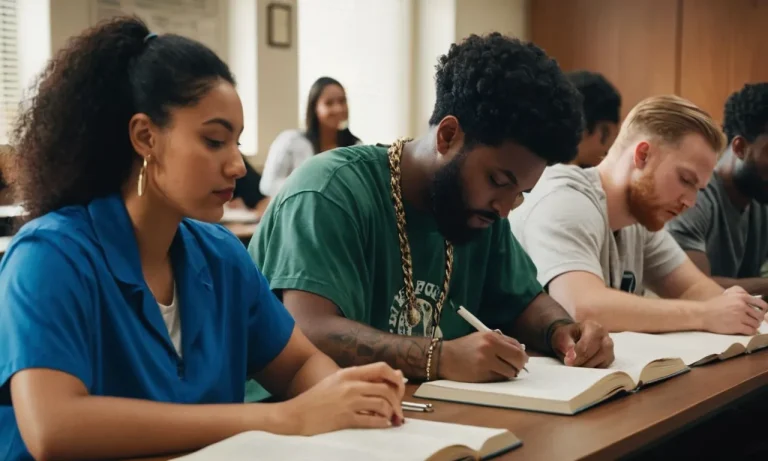As a high school student, navigating the complex world of academic credits can be a daunting task. With graduation requirements looming and college aspirations on the horizon, understanding the appropriate number of credits to accumulate by your junior year is crucial.
If you’re short on time, here’s a quick answer to your question: A high school junior should typically aim for around 16-18 credits by the end of their junior year, depending on the specific graduation requirements of their school district and state.
In this comprehensive guide, we’ll delve into the intricacies of high school credit requirements, explore the factors that influence the recommended number of credits for juniors, and provide valuable insights to help you stay on track for a successful academic journey.
Understanding High School Credits
As students navigate their way through high school, understanding the concept of credits becomes crucial. Credits are like the currency of academic progress, representing the successful completion of a course or subject. Let’s dive into this topic and explore the importance of high school credits.
What are High School Credits?
High school credits are units awarded to students upon satisfactory completion of a course or subject. Each credit typically represents a certain number of instructional hours, often ranging from 60 to 120 hours per credit, depending on the school district or state.
Credits serve as a measure of academic achievement and are essential for meeting graduation requirements.
Typical Credit Requirements for Graduation
While credit requirements may vary across states and districts, most high schools follow a similar pattern. Generally, students are expected to accumulate a specific number of credits in core subjects like English, mathematics, science, social studies, and electives to earn their high school diploma.
Here’s a typical breakdown of credit requirements:
- English: 4 credits
- Mathematics: 3-4 credits
- Science: 3-4 credits
- Social Studies: 3-4 credits
- Physical Education/Health: 1-2 credits
- Electives: 5-7 credits
The total number of credits required for graduation can range from 20 to 28 credits, depending on the state or district. For example, according to Education Week, the state of New York requires a minimum of 22 credits for graduation, while California mandates a minimum of 13 credits.
Variations Across States and School Districts
While there are general guidelines, credit requirements can vary significantly across states and even school districts within the same state. Some states have more rigorous requirements, mandating additional credits in specific subject areas or allowing for more flexibility in elective choices.
It’s always a good idea to check with your school district or state education department for the most up-to-date and accurate information.
Additionally, some schools offer opportunities for students to earn additional credits through advanced placement (AP) courses, dual enrollment programs with local colleges, or online courses. These options provide students with the chance to explore their interests further and potentially earn college credits while still in high school.
Isn’t that awesome? 😎
As a high school junior, it’s essential to stay on top of your credit accumulation and make sure you’re on track to meet the graduation requirements. Don’t hesitate to consult with your school counselor or academic advisor for guidance and support throughout this exciting journey.
Remember, staying informed and proactive about your credits is the key to a successful high school experience and a smooth transition to your future endeavors.
Factors Influencing Credit Requirements for Juniors
Academic Goals and College Aspirations
As a high school junior, the number of credits you need to earn depends largely on your academic goals and aspirations for college. If you plan to attend a highly competitive university, you’ll likely need to exceed the minimum credit requirements to demonstrate your academic rigor and commitment.
According to CollegeBoard, top-tier colleges often look for students who have taken the most challenging courses available, including Advanced Placement (AP) or International Baccalaureate (IB) classes.
Earning additional credits in these advanced courses can boost your chances of admission and potentially earn you college credit as well.
On the other hand, if you’re considering a less competitive college or have plans to enter the workforce directly after high school, meeting the minimum credit requirements may be sufficient. However, it’s always a good idea to challenge yourself academically and explore your interests through elective courses.
Who knows, you might discover a passion you never knew you had! 😊
Course Load and Scheduling Considerations
The number of credits a junior needs to earn is also influenced by their course load and scheduling considerations. Most high schools have a set number of required courses in core subjects like English, math, science, and social studies, as well as elective options.
According to the Education Commission of the States, the average state requirement for high school graduation is around 20 credits or units. However, some states and districts may have higher or lower requirements.
It’s important to work closely with your school counselor to ensure you’re on track to meet graduation requirements while also leaving room for electives or advanced courses that align with your interests and goals.
Careful planning and time management are key to balancing a rigorous course load without feeling overwhelmed. 👏
Extracurricular Activities and Time Management
While academic coursework is undoubtedly the top priority for high school juniors, many students also juggle extracurricular activities, part-time jobs, or family responsibilities. These commitments can impact the number of credits a student can realistically handle in a given semester or year.
According to a study by the National Center for Education Statistics, approximately 57% of high school students participate in at least one extracurricular activity.
Time management skills are crucial for balancing a demanding course load with other obligations. Students may need to prioritize their activities and commitments, or consider taking a lighter course load during particularly busy semesters.
It’s also important to leave room for self-care and relaxation to avoid burnout. Remember, your mental and physical health should always come first! 🙌
Recommended Credit Distribution for Juniors
Core Academic Subjects (English, Math, Science, Social Studies)
As a high school junior, it’s crucial to prioritize core academic subjects like English, math, science, and social studies. These courses form the foundation of your education and are essential for college admission and future success.
The recommended credit distribution for these subjects typically includes:
- English: 1 credit (e.g., American Literature, World Literature)
- Math: 1 credit (e.g., Algebra II, Pre-Calculus, Calculus)
- Science: 1 credit (e.g., Chemistry, Physics, Biology)
- Social Studies: 1 credit (e.g., U.S. History, World History, Economics)
These core subjects not only prepare you for standardized tests like the SAT and ACT but also develop critical thinking, problem-solving, and communication skills that are invaluable in any career path.
According to the College Board, students who take rigorous coursework in high school are more likely to succeed in college and beyond.
Elective Courses and Specialized Programs
While core academic subjects are essential, elective courses and specialized programs can enrich your high school experience and help you explore your interests and passions. As a junior, you may want to consider taking elective courses in areas such as:
- Fine Arts (e.g., Music, Art, Drama)
- Foreign Languages
- Computer Science
- Business and Entrepreneurship
- Career and Technical Education (CTE) programs
Elective courses not only provide a well-rounded education but also allow you to explore potential career paths and develop skills that can set you apart in college applications. Additionally, many high schools offer specialized programs like International Baccalaureate (IB), STEM (Science, Technology, Engineering, and Math), or career academies that provide unique learning opportunities and prepare you for specific fields of study or careers.
Advanced Placement (AP) and Honors Courses
As a high school junior, you may want to consider taking Advanced Placement (AP) or honors courses, which are more challenging and rigorous than regular courses. These courses can help you stand out in the college admission process and potentially earn college credit, saving you time and money in the long run.
According to the College Board, students who take AP courses are more likely to graduate from college in four years or less.
AP courses are offered in a variety of subjects, including English, math, science, social studies, and more. Honors courses are also available in many high schools and cover similar content at a more advanced level.
Taking AP and honors courses not only demonstrates your academic ability and commitment but also prepares you for the demands of college-level coursework.
Remember, the recommended credit distribution may vary depending on your individual goals, interests, and the requirements of the colleges or universities you plan to apply to. It’s always a good idea to consult with your school counselor or academic advisor to ensure you’re on track for graduation and meeting the necessary requirements for your desired post-secondary path.
| Course Type | Recommended Credits for Juniors |
|---|---|
| Core Academic Subjects | 4 credits (1 credit each in English, Math, Science, and Social Studies) |
| Elective Courses | 1-2 credits |
| AP or Honors Courses | 1-2 credits |
For more information and guidance, you can refer to authoritative websites like College Board, National Center for Education Statistics, and ACT.
Strategies for Staying on Track
As a high school junior, staying on track academically is crucial for ensuring a successful path toward graduation and future college or career endeavors. With the increasing demands and complexities of academic requirements, it’s essential to adopt effective strategies to navigate this pivotal year.
By developing a personalized academic plan, seeking guidance from school counselors, and utilizing online resources and credit tracking tools, students can proactively manage their progress and stay ahead of the curve.
Developing a Personalized Academic Plan
A personalized academic plan serves as a roadmap, tailored to each student’s unique goals, strengths, and interests. This plan should outline the required courses, electives, and extracurricular activities that align with their post-secondary aspirations.
By creating a comprehensive plan, students can better visualize their path and make informed decisions about course selections and credit requirements. According to CollegeBoard, a reputable website for college planning, “A well-crafted academic plan can help students stay motivated, focused, and on track throughout their high school journey.”
Seeking Guidance from School Counselors
School counselors are invaluable resources for students navigating the complexities of high school. These professionals are well-versed in graduation requirements, college admissions processes, and career exploration.
By scheduling regular meetings with their counselors, students can receive personalized advice, clarify any doubts or concerns, and ensure they are meeting all necessary credit requirements. As reported by National Association for College Admission Counseling, “Students who work closely with their school counselors are more likely to stay on track and achieve their academic goals.”
Utilizing Online Resources and Credit Tracking Tools
In today’s digital age, a plethora of online resources and credit tracking tools are available to assist students in monitoring their academic progress. Websites like Khan Academy and Coursera offer a wealth of educational content, supplemental materials, and even credit-bearing courses.
Additionally, many schools provide online portals or apps that allow students to track their credits, view transcripts, and plan their course schedules. By leveraging these tools, students can stay informed, identify potential gaps or deficiencies, and make informed decisions about their academic journey.
Staying on track as a high school junior is a challenging but achievable goal. By embracing these strategies and taking a proactive approach, students can navigate the academic landscape with confidence and set themselves up for success in their future endeavors.
Remember, it’s never too early (or too late) to start planning and seeking support – the key is to stay focused, organized, and committed to your educational journey. With determination and the right resources, you can conquer this critical year and pave the way for a bright future ahead. 😊💪
Conclusion
Determining the appropriate number of credits for a high school junior is a multifaceted endeavor that requires careful consideration of various factors. By understanding the fundamentals of high school credit systems, aligning your academic goals with course selections, and employing effective strategies for staying on track, you can navigate this crucial phase of your educational journey with confidence.
Remember, the recommended credit range of 16-18 credits by the end of your junior year is a general guideline, and it’s essential to consult with your school counselors and review your specific graduation requirements.
With diligence, time management, and a proactive approach, you can position yourself for academic success and pave the way for a bright future beyond high school.





